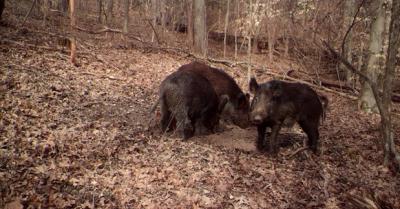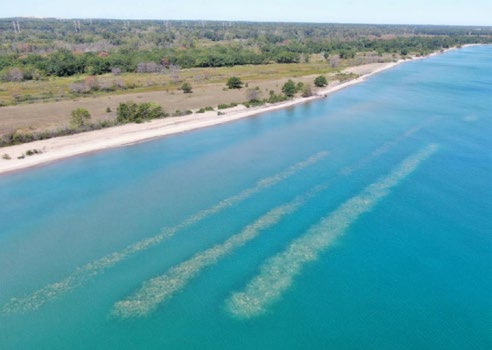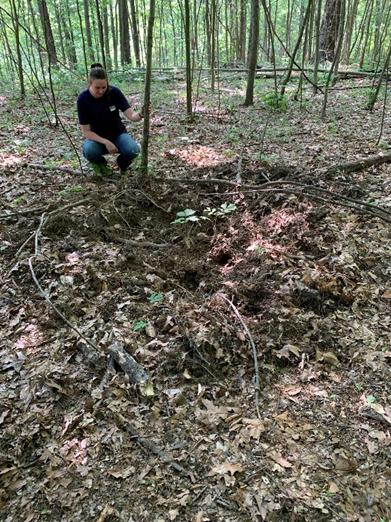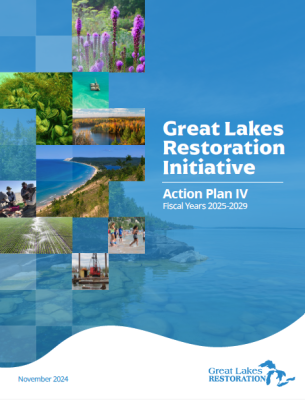Author: Cottage Life
Final Remaining BUI, Degradation of Benthos, Removed at Muskegon Lake AOC
Final Remaining BUI, Degradation of Benthos, Removed at Muskegon Lake AOC
josterme01
Thu, 12/12/2024 – 2:00 pm
Mechanical dredging of contaminated sediment in Ryerson Creek in the Muskegon Lake AOC.
The U.S. EPA, together with the Michigan Department of Environment, Great Lakes, and Energy (EGLE), Water Resources Division (WRD), and Area of Concern (AOC) Program, has removed the Degradation of Benthos BUI from the Muskegon Lake AOC. The BUI was removed on October 31st, 2024, and was the first BUI removed under the Great Lakes Restoration Initiative (GLRI) Action Plan IV. BUIs are designations listed in the 1987 amendment to the Great Lakes Water Quality Agreement (GLWQA) that represent different types of significant environmental degradation (see Beneficial Use Impairments for the Great Lakes AOCs to learn more).
Muskegon Lake was originally listed as an AOC in 1987 due to historic discharges of industrial and municipal wastewater as well as urban runoff. Elevated levels of contaminants including heavy metals and oils degraded benthic communities by reducing diversity. Since then, 190,000 cubic yards of contaminated sediment in the AOC have been remediated by Great Lakes Legacy Act (GLLA) projects, reducing toxicity that impacted benthic communities. Additionally, seven habitat projects were completed in the AOC, restoring approximately 134 acres of habitat, and removing 110,000 tons of logging-era sawmill debris from the lake.
The completion of these projects has culminated in the restoration of the AOC and removal of all nine identified BUIs. The October 31, 2024, removal of the Degradation of Benthos BUI marked the ninth and final BUI removal. With all BUIs removed, the Muskegon Lake AOC is now eligible for delisting, a monumental accomplishment in the AOC program. Once an area is delisted, it is no longer considered an AOC as all its once-impaired beneficial uses have been restored. Of 31 U.S. AOCs, only seven have been delisted since the program began in 1987. All but one of these AOCs have been delisted since the GLRI was established in 2010. The delisting process includes the development of a Delisting Report, an invitation to tribes to consult on the delisting recommendation, and a review by the International Joint Commission (IJC) and the public.
The beginning of the delisting process at Muskegon Lake AOC will come on the heels of another recent delisting. Rochester Embayment was delisted on October 3, 2024 following the removal of all 14 of its original BUIs. Each delisting constitutes an historic achievement in the restoration of the Great Lakes and a notable success under both the GLWQA and the GLRI. The proposed future delisting of Muskegon Lake in 2025 would be the eighth delisting of a U.S. AOC and a celebration of decades of hard work by federal, state, and local partners.
Thu, 12/12/2024 – 2:00 pm
Keywords
Mechanical dredging of contaminated sediment in Ryerson Creek in the Muskegon Lake AOC.
The U.S. EPA, together with the Michigan Department of Environment, Great Lakes, and Energy (EGLE), Water Resources Division (WRD), and Area of Concern (AOC) Program, has removed the Degradation of Benthos BUI from the Muskegon Lake AOC. The BUI was removed on October 31st, 2024, and was the first BUI removed under the Great Lakes Restoration Initiative (GLRI) Action Plan IV. BUIs are designations listed in the 1987 amendment to the Great Lakes Water Quality Agreement (GLWQA) that represent different types of significant environmental degradation (see Beneficial Use Impairments for the Great Lakes AOCs to learn more).
Muskegon Lake was originally listed as an AOC in 1987 due to historic discharges of industrial and municipal wastewater as well as urban runoff. Elevated levels of contaminants including heavy metals and oils degraded benthic communities by reducing diversity. Since then, 190,000 cubic yards of contaminated sediment in the AOC have been remediated by Great Lakes Legacy Act (GLLA) projects, reducing toxicity that impacted benthic communities. Additionally, seven habitat projects were completed in the AOC, restoring approximately 134 acres of habitat, and removing 110,000 tons of logging-era sawmill debris from the lake.
The completion of these projects has culminated in the restoration of the AOC and removal of all nine identified BUIs. The October 31, 2024, removal of the Degradation of Benthos BUI marked the ninth and final BUI removal. With all BUIs removed, the Muskegon Lake AOC is now eligible for delisting, a monumental accomplishment in the AOC program. Once an area is delisted, it is no longer considered an AOC as all its once-impaired beneficial uses have been restored. Of 31 U.S. AOCs, only seven have been delisted since the program began in 1987. All but one of these AOCs have been delisted since the GLRI was established in 2010. The delisting process includes the development of a Delisting Report, an invitation to tribes to consult on the delisting recommendation, and a review by the International Joint Commission (IJC) and the public.
The beginning of the delisting process at Muskegon Lake AOC will come on the heels of another recent delisting. Rochester Embayment was delisted on October 3, 2024 following the removal of all 14 of its original BUIs. Each delisting constitutes an historic achievement in the restoration of the Great Lakes and a notable success under both the GLWQA and the GLRI. The proposed future delisting of Muskegon Lake in 2025 would be the eighth delisting of a U.S. AOC and a celebration of decades of hard work by federal, state, and local partners.
Thu, 12/12/2024 – 2:00 pm
Keywords
The ultimate invader: USDA Wildlife Services works to minimize feral swine threats to the Great Lakes ecosystem
The ultimate invader: USDA Wildlife Services works to minimize feral swine threats to the Great Lakes ecosystem
josterme01
Tue, 12/03/2024 – 11:53 am

Invasive species are defined as plants or animals that are nonnative to an ecosystem and often have broad negative impacts on the environment when introduced. Feral swine (Sus scrofa) may be the ultimate invader. They are cryptic, opportunistic, efficient, and highly adaptable. Feral swine damage to habitats, predation on wildlife, and disease transmission can be linked to the decline of hundreds of native plants and animals in the United States
The primary methods by which feral swine populations emerge on the landscape are through illegal transportation and release; domestic and agricultural escapes; and escapes from hunting preserves. Each of these pathways highlight the complex challenge in controlling feral swine populations.
Wildlife Services and their partners continue to operate within the Great Lakes Restoration Initiative (GLRI) to implement on the ground control activities and promote outreach to prevent new introductions of feral swine in Michigan and Ohio. Increased monitoring efforts, coupled with rapid detection and early response, have lowered feral swine densities in Michigan. In Ohio, Wildlife Services has removed one emergent feral swine population and prevented two others from establishing themselves on the landscape.
Thorough surveillance, including the use of camera traps, helicopters, and public outreach has ensured these areas remain feral swine free. Dedicated wildlife damage management efforts like these by USDA Wildlife Services remain important to the conservation of habitat and promotion of native species biodiversity in the Great Lakes ecosystem.
Learn more about how USDA Wildlife Services is managing feral swine damage.
The ultimate invader: USDA Wildlife Services works to minimize feral swine threats to the Great Lakes ecosystem
The ultimate invader: USDA Wildlife Services works to minimize feral swine threats to the Great Lakes ecosystem
josterme01
Tue, 12/03/2024 – 11:53 am
Feral swine feeding along a ridgetop.
Invasive species are defined as plants or animals that are nonnative to an ecosystem and often have broad negative impacts on the environment when introduced. Feral swine (Sus scrofa) may be the ultimate invader. They are cryptic, opportunistic, efficient, and highly adaptable. Feral swine damage to habitats, predation on wildlife, and disease transmission can be linked to the decline of hundreds of native plants and animals in the United States
The primary methods by which feral swine populations emerge on the landscape are through illegal transportation and release; domestic and agricultural escapes; and escapes from hunting preserves. Each of these pathways highlight the complex challenge in controlling feral swine populations.
Feral swine damage in a forest ecosystem.
Wildlife Services and their partners continue to operate within the Great Lakes Restoration Initiative (GLRI) to implement on the ground control activities and promote outreach to prevent new introductions of feral swine in Michigan and Ohio. Increased monitoring efforts, coupled with rapid detection and early response, have lowered feral swine densities in Michigan. In Ohio, Wildlife Services has removed one emergent feral swine population and prevented two others from establishing themselves on the landscape.
Thorough surveillance, including the use of camera traps, helicopters, and public outreach has ensured these areas remain feral swine free. Dedicated wildlife damage management efforts like these by USDA Wildlife Services remain important to the conservation of habitat and promotion of native species biodiversity in the Great Lakes ecosystem.
Learn more about how USDA Wildlife Services is managing feral swine damage.
Tue, 12/03/2024 – 11:53 am
Keywords
Feral swine feeding along a ridgetop.
Invasive species are defined as plants or animals that are nonnative to an ecosystem and often have broad negative impacts on the environment when introduced. Feral swine (Sus scrofa) may be the ultimate invader. They are cryptic, opportunistic, efficient, and highly adaptable. Feral swine damage to habitats, predation on wildlife, and disease transmission can be linked to the decline of hundreds of native plants and animals in the United States
The primary methods by which feral swine populations emerge on the landscape are through illegal transportation and release; domestic and agricultural escapes; and escapes from hunting preserves. Each of these pathways highlight the complex challenge in controlling feral swine populations.
Feral swine damage in a forest ecosystem.
Wildlife Services and their partners continue to operate within the Great Lakes Restoration Initiative (GLRI) to implement on the ground control activities and promote outreach to prevent new introductions of feral swine in Michigan and Ohio. Increased monitoring efforts, coupled with rapid detection and early response, have lowered feral swine densities in Michigan. In Ohio, Wildlife Services has removed one emergent feral swine population and prevented two others from establishing themselves on the landscape.
Thorough surveillance, including the use of camera traps, helicopters, and public outreach has ensured these areas remain feral swine free. Dedicated wildlife damage management efforts like these by USDA Wildlife Services remain important to the conservation of habitat and promotion of native species biodiversity in the Great Lakes ecosystem.
Learn more about how USDA Wildlife Services is managing feral swine damage.
Tue, 12/03/2024 – 11:53 am
Keywords
EPA Announces New 5-Year Plan to Accelerate Restoration of the Great Lakes
EPA Announces New 5-Year Plan to Accelerate Restoration of the Great Lakes
josterme01
Fri, 11/29/2024 – 9:22 am

Today, U.S. Environmental Protection Agency announced an updated action plan for federal agencies and their partners under the Great Lakes Restoration Initiative to restore and protect the Great Lakes over the next five years. The plan was informed by extensive public engagement and consultation with Great Lakes Tribes and states.
Last summer, EPA and its federal partners received more than 3,500 suggestions from the public on priorities for Action Plan IV through five public engagement sessions across the Great Lakes basin and two virtual engagement sessions. In addition, EPA released a draft of the GLRI Action Plan IV for public input earlier this year. Over 40 sets of public input from organizations and individuals were received and incorporated into GLRI Action Plan IV.
Action Plan IV outlines the GLRI’s priorities and goals for 2025 to 2029 in five focus areas:
- Toxic Substances and Areas of Concern;
- Invasive Species;
- Nonpoint Source Pollution;
- Habitat and Species; and
- Foundations for Future Restoration Actions.
The GLRI has been a catalyst for unprecedented federal agency coordination that has accordingly produced unprecedented results. Six U.S. Areas of Concern have been delisted since GLRI’s start and the 24 remaining Areas of Concern have moved dramatically closer to their delisting. This activity reflects a major change from the 25 years before the GLRI, when only one Area of Concern was cleaned up and delisted. GLRI resources have also been used for projects that have prevented over 2.3 million pounds of phosphorus from entering the Great Lakes between 2015 and 2022 and have reduced the phosphorus runoff contribution to harmful algal blooms in western Lake Erie, Saginaw Bay and Green Bay.
The GLRI also produces economic benefits — a 2018 University of Michigan study showed that every dollar of federal spending on GLRI projects between 2010 and 2016 will produce $3.35 in additional economic activity in the Great Lakes region through 2036.
In the coming weeks, a web-version of Action Plan IV will be available.
EPA Announces New 5-Year Plan to Accelerate Restoration of the Great Lakes
EPA Announces New 5-Year Plan to Accelerate Restoration of the Great Lakes
josterme01
Fri, 11/29/2024 – 9:22 am
Aerial view of a GLRI project which installed submerged rubble ridges at Illinois Beach State Park. Photo credit: US Army Corps of Engineers
Today, U.S. Environmental Protection Agency announced an updated action plan for federal agencies and their partners under the Great Lakes Restoration Initiative to restore and protect the Great Lakes over the next five years. The plan was informed by extensive public engagement and consultation with Great Lakes Tribes and states.
Last summer, EPA and its federal partners received more than 3,500 suggestions from the public on priorities for Action Plan IV through five public engagement sessions across the Great Lakes basin and two virtual engagement sessions. In addition, EPA released a draft of the GLRI Action Plan IV for public input earlier this year. Over 40 sets of public input from organizations and individuals were received and incorporated into GLRI Action Plan IV.
GLRI Action Plan IV
Action Plan IV outlines the GLRI’s priorities and goals for 2025 to 2029 in five focus areas:
- Toxic Substances and Areas of Concern;
- Invasive Species;
- Nonpoint Source Pollution;
- Habitat and Species; and
- Foundations for Future Restoration Actions.
The GLRI has been a catalyst for unprecedented federal agency coordination that has accordingly produced unprecedented results. Six U.S. Areas of Concern have been delisted since GLRI’s start and the 24 remaining Areas of Concern have moved dramatically closer to their delisting. This activity reflects a major change from the 25 years before the GLRI, when only one Area of Concern was cleaned up and delisted. GLRI resources have also been used for projects that have prevented over 2.3 million pounds of phosphorus from entering the Great Lakes between 2015 and 2022 and have reduced the phosphorus runoff contribution to harmful algal blooms in western Lake Erie, Saginaw Bay and Green Bay.
The GLRI also produces economic benefits — a 2018 University of Michigan study showed that every dollar of federal spending on GLRI projects between 2010 and 2016 will produce $3.35 in additional economic activity in the Great Lakes region through 2036.
In the coming weeks, a web-version of Action Plan IV will be available.
Fri, 11/29/2024 – 9:22 am
Keywords
Aerial view of a GLRI project which installed submerged rubble ridges at Illinois Beach State Park. Photo credit: US Army Corps of Engineers
Today, U.S. Environmental Protection Agency announced an updated action plan for federal agencies and their partners under the Great Lakes Restoration Initiative to restore and protect the Great Lakes over the next five years. The plan was informed by extensive public engagement and consultation with Great Lakes Tribes and states.
Last summer, EPA and its federal partners received more than 3,500 suggestions from the public on priorities for Action Plan IV through five public engagement sessions across the Great Lakes basin and two virtual engagement sessions. In addition, EPA released a draft of the GLRI Action Plan IV for public input earlier this year. Over 40 sets of public input from organizations and individuals were received and incorporated into GLRI Action Plan IV.
GLRI Action Plan IV
Action Plan IV outlines the GLRI’s priorities and goals for 2025 to 2029 in five focus areas:
- Toxic Substances and Areas of Concern;
- Invasive Species;
- Nonpoint Source Pollution;
- Habitat and Species; and
- Foundations for Future Restoration Actions.
The GLRI has been a catalyst for unprecedented federal agency coordination that has accordingly produced unprecedented results. Six U.S. Areas of Concern have been delisted since GLRI’s start and the 24 remaining Areas of Concern have moved dramatically closer to their delisting. This activity reflects a major change from the 25 years before the GLRI, when only one Area of Concern was cleaned up and delisted. GLRI resources have also been used for projects that have prevented over 2.3 million pounds of phosphorus from entering the Great Lakes between 2015 and 2022 and have reduced the phosphorus runoff contribution to harmful algal blooms in western Lake Erie, Saginaw Bay and Green Bay.
The GLRI also produces economic benefits — a 2018 University of Michigan study showed that every dollar of federal spending on GLRI projects between 2010 and 2016 will produce $3.35 in additional economic activity in the Great Lakes region through 2036.
In the coming weeks, a web-version of Action Plan IV will be available.
Fri, 11/29/2024 – 9:22 am
Keywords












